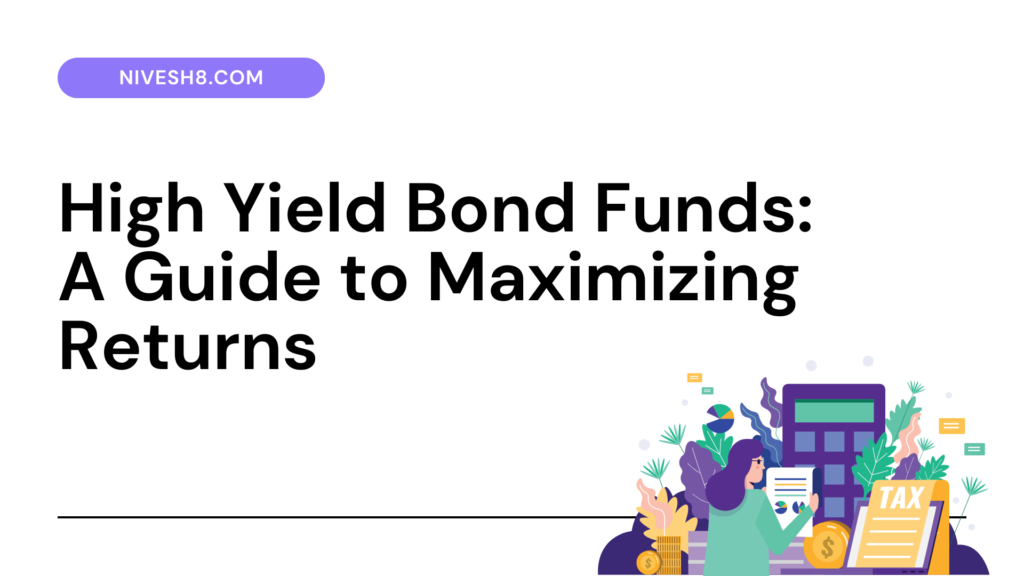Investors wishing to boost the income from their portfolios often make use of high yield bond funds. Though they pay better interest rates to offset the higher risk, these funds mostly invest in lower credit-rated corporate bonds. If you are ready to accept a little more risk in order to earn better returns, high yield bond funds could be a fantastic addition to your investing plan. Let’s investigate what high yield bond funds are, their benefits and disadvantages, and how you might best use them.
Discuss High Yield Bond Funds
High yield bond funds, also known as mutual funds or exchange-traded funds (ETFs), invest in bonds issued by companies with lower credit ratings. Sometimes referred to as “junk bonds,” they are rated below investment grade (BB+ or lower by Standard & Poor’s and Ba1 or lower by Moody’s). Since their lower credit quality causes higher interest rates than those of investment-grade bonds, these bonds attract income-seeking investors ready to assume more risk.
Why Should One Make High Yield Bond Investments?
High Yield Bond Funds appeal to investors because of their potential for higher returns compared to conventional government or investment-grade corporate bonds. By spreading their high-yield bond investments among several industries, these funds reduce the risk related to individual bond defaults.
For those aiming to establish consistent cash flow, these funds are suitable.
- Possibility of Capital Appreciation: Bond prices could rise, producing capital gains should the issuer’s financial situation improve.
- More yields: These can help to offset inflation and maintain buying power.
High Yield Bond Forms
Their investment concentration determines the several types of high yield bond funds:
- Home-based high yield bond funds: Emphasize bonds generated by Indian companies.
- International high yield bond funds: Invest in high-yield bonds produced globally.
- Funds for Short-Term High Yield Bonds: These funds define short maturities and less sensitivity to changes in interest rates.
- Extended Timescale High Yield Bond Funds: Rising interest rates affect these funds more, though their yields are better.
- Sector-Specific High Yield Bond Funds: Focus on industries like real estate, technology, or energy.
Higher income potential and usually far better yields than government or investment-grade bonds define high yield bond funds. In view of safer assets, especially, adding high yield bond funds to a portfolio helps balance risk. Greater yields could help to offset the effects of inflation. By improving economic conditions, the credit quality of the underlying bonds will increase, enhancing the value of the fund. Payments made monthly or quarterly attract income-oriented investors looking for consistent cash flow.
High Yield Bond Funds: Risk Factors
High yield bond funds come with some risks, despite the allure of potential returns:
- Credit Risk: The likelihood that the bond issuer may fail on principal or interest payments.
- Rising Interest Rates: Can reduce bond values, especially for long-term investments.
- Economic Sensitivity: Unlike more highly rated bonds, economic downturns have more impact on high yield bonds.
- Liquidity Risk: Particularly in a market under stress, some high-yield bonds could be difficult to sell.
- Market Sensitivity: The value of the fund can change significantly depending on the state of the market.
How One Should Choose Superior High Yield Bond Funds
- Look for funds with a diversified portfolio to help minimize the impact of one default.
- Make sure the yield corresponds to the degree of credit risk involved.
- Low management fee funds will enable you to maximize net returns.
- Analyzing past performance will enable you to better appreciate how the fund has handled various market conditions.
- Shorter terms might reduce yields but also reduce interest rate sensitivity.
- Good fund managers maximize returns and control risks through expert knowledge.
Top Guidelines About Investing in High Yield Bonds
- Distribute your fixed-income investments among high-yield funds instead of focusing all of them on one fund.
- Track financial indicators: Pay close attention to economic projections and interest rates since these influence bond prices.
- Reinvesting interest payments could let you benefit from compounding.
- High yields expose more risk, so be prepared for fluctuations in prices.
- Ensure that your financial goals and risk tolerance align with your investment.
Sample High Yield Bond Fund
Should you invest ₹1,00,000 in an 8% annual yielding high yield bond fund, your expected annual return would be: ₹1,00,000 x 8% = ₹8,000.
Net return after fees: ₹8,000 – expense ratio (say 1%) = ₹7,000
Though this yield is attractive, keep in mind that bond values vary, and the income is not guaranteed.
For Whom Should One Invest in High Yield Bond Funds?
- Income-oriented investors looking for more returns than those of government bonds.
- Long-term investors able to withstand brief swings in order to gain from better rates.
- Risk-tolerant investors—that is, those comfortable with the possibility of bond defaults.
- Diversified Portfolio Seekers: Those wishing to add fixed-income assets without sacrificing returns.
Should One Avoid High Yield Bond Funds During a Recession?
- Companies with low credit ratings are more likely to fail.
- As interest rates climb, the value of current bonds could drop, affecting fund performance.
- If stability is what conservatives seek, the volatility may disturb them.
Last Notes
Investing in high yield bond funds can be a great approach to generate large income, even if they carry more risk than regular bonds. Before investing, closely review your risk tolerance, financial goals, and market conditions. Maximizing this opportunity will rely on diversifying your investments and choosing outstanding funds with a solid history. When investigating high-yield investments, keep informed, stay diversified, and consult professionals.

